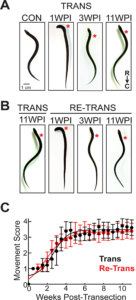Inspired by Marine Life
Imagine if humans could regenerate body parts – if amputees or victims of spinal cord injuries could recover their very own limbs or physical movement.

Scientists are trying to imagine this future right now, drawing inspiration from marine life. From horseshoe crab blood to bioluminescent, deep-sea crustaceans, marine organisms have been inspiring various healthcare breakthroughs for years. We’ve already learned so much about tissue and organ recovery from zebrafish, which can regenerate complex organs including their hearts, and axolotls, which can regenerate entire limbs.
The natural world has demonstrated successful regeneration for centuries, so now we’re also exploring if body parts still regenerate after repeated injuries. Hanslik et al. (2019) tested this question by conducting an experiment on sea lampreys.
The Toothy Subject
Sea lampreys are cartilaginous critters inhabiting northern and western Atlantic waters. Unlike bony fish, these ancient animals do not have any scales, fins, or external gill flaps. To add to their unique flare, lampreys can regenerate their spinal cord after it’s been cut through and eventually start swimming normally again.
The research team found that, concurrent with previous research, the sea lampreys rapidly regained normal swimming patterns after initial spinal severance. Just 11 weeks after the surgery that cut their spinal cords, lampreys resumed these standard behaviors, swimming as well as uninjured sea lampreys.
Regeneration Take Two

At this point, the lampreys underwent another surgery that cut their spinal cords in the same spot. Hanslik and her team encountered something noteworthy: lampreys that had their spinal cords severed twice recovered with a similar speed as lampreys that had their spinal cords severed only once. This meant that just 11 weeks after their second spinal cord injury, lampreys went from abnormal movements (like rapid head swaying, uncharacteristic body contractions, and smaller side-to-side swimming motions) to their typical swimming movements. Not only did the team see striking similarities in behavioral recovery between each group of lampreys, they also noted similarities in spinal cord tissue growth, and nerve regeneration and survival.
Hanslik et al. (2019) explained that while lampreys did recover their normal swimming patterns, their spinal cords didn’t return back to their original state. Rather, the scientists found the lampreys showed remarkable nerve plasticity after both the first and second spinal cord injury. That means that rather than reversing back to their pre-injured condition, the animals rewired the nerves in the spinal cords and formed a new network of connections between the nerve cells.
What’s Next?
Further work on lamprey regeneration should examine how lampreys recover after more than 2 spinal severances, as some animals like axolotls and newts demonstrate lowered regenerative capabilities after each successive injury. Future work should also explore how these animals recover after an injury to different spinal cord nerves responsible for other senses or behaviors, like touch. Understanding the technicalities of how nerve cells in injured lamprey spinal cords regenerate, and what stimulates a halt or reduced regeneration, brings us closer to recognizing the barriers humans face in spinal cord regeneration.
As medicine progresses, scientists like Hanslik et al. (2019) will continue drawing information from marine life and the adaptations that have kept ancient critters, like the 360 million year old sea lamprey, alive for so long. There is much we can learn from the big blue world beneath us when imagining our future.
Rishya is a multimedia science communicator with an MS in Media Advocacy from Northeastern University, specializing in Environmental Science Communications and Policy. She spent a year in informal education and policy advocacy at the New England Aquarium as an Educator and at Save the Harbor/Save the Bay as their Communications and Public Relations Coordinator. She also interned for PBS science series, NOVA and was awarded a 2019 Rapport Public Policy Fellowship, which she served at the Massachusetts Division of Marine Fisheries. Rishya’s areas of focus are environmental science, marine science, climate change…and video games!


